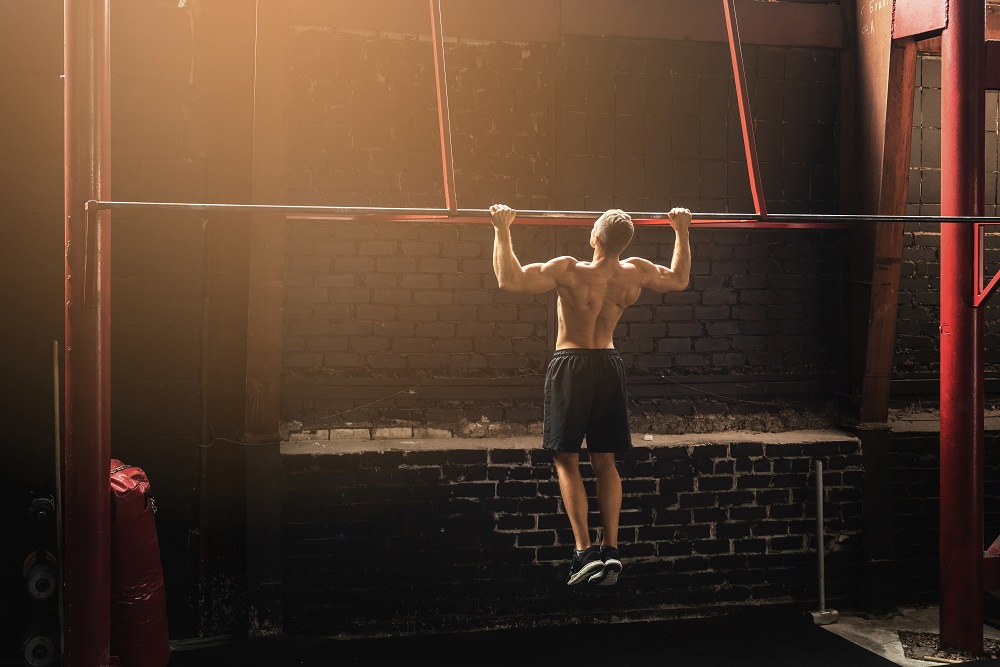Disclosure: This post contains affiliate links. Meaning if you click on a link and make a purchase, I'll earn a small commission at no extra cost to you.
I’m just gonna come straight out of the gate and say that given the choice of calisthenics vs weights…
…My heart will always be true to the pullup bar and NOT the barbell.
Now I’m not saying there’s anything wrong with weightlifting.
The first time I ever got truly jacked was when I followed a traditional weight lifting routine.
But over time, I didn’t see how MOST of the exercises transferred over into real-world function.
There are exceptions…
…Deadlifting
…Squatting
…Landmine 180’s for rotational strength.
These all have great carryover into functional movement patterns depending on your sport.
Other than that, there’s nothing I can do in the weight room that can’t be done by using a pullup bar and my body weight.
But that’s just me.
Anyway…
You’re here because you want a side by side comparison of both calisthenics vs weights.
So, without further ado, let the battle begin…
Table of Contents
Calisthenics

Calisthenics involves any exercise that uses your body weight.
…Pullups
…Dips
…Pushups
… Bodyweight squats
These are all examples of calisthenics moves in there most basic form.
Thing is, most people don’t realize that progressive calisthenics goes way beyond these few basic moves.
Look at the insane strength of some of the world’s top calisthenics athletes and tell me you’re not impressed by some of the things they can do.
How do they do it?
One word…
…Leverage.
And it can turn the simplest exercises into almost impossible strength moves.
Are pushups too easy?
Try doing 10 strict one-arm pushups.
Squats not doing it for you?
Do a pistol squat without falling on your ass.
Is it perfect?
No
Despite all its positives, Calisthenics isn’t for everyone.
Firstly, it can get frustrating.
And progressing to move advanced exercises can sometimes take months of hard work to pay off.
But if you’ve got the determination to push yourself past these little hurdles then it’s worth it.
WATCH VIDEO: How To QUICKLY Master The Planche, Muscle-Up, Human Flag, And Other Advanced Calisthenic Moves That Defy The Law Of Gravity
(Video Will Open In A New Window)
Weights
Weights are better if you’re looking for something simple.
It’s easy to track your progress and there’s no complex variations or advanced moves to derail your focus.
You just pick a routine. Then work towards progressively overloading your muscles by lifting more.
The drawback though is it lacks functionality and can get a bit boring.
And if you don’t have a goal. Then it can sometimes take a toll on your enthusiasm for the iron game.

Calisthenics Vs Weights – Which Is Better?
Well, that all depends on what your goals are.
Both training methods are different so the first thing you need to think about is…
…Why do you want to work out?
…What does your finished result look like?
…And also, which training method do you enjoy more?
If you just want to look good…
…or you want to build slabs of muscle that could scare away a pack of wild hyenas.
Then weight lifting’s probably your best bet.
But if your focus is both real-world functionality and relative strength.
And you want to learn advanced bodyweight exercises to show off to your gym buddies.
Then calisthenics is the one you want.
Functional Strength

Functional Strength is defined as the ability to perform a specific movement or activity.
It’s more about working your body as a whole by doing exercises that make it easier to perform physical aspects of your everyday life.
This is where calisthenics reigns supreme. Because let’s be honest, everything about it is based on functionality.
How often have you done a heavy lifting session at the gym, only to be unable to move your body for the next 3 days because you’re too damn sore?
And let’s not forget isolation exercises like bicep curls and tricep extensions.
Although great for giving you a quick pump. They rarely have any natural carryover into any functional movement.
Having said that, weights have their place in the world of functional strength.
When performed right.
Heavy compound movements such as deadlifts…
…kettlebells swings.
…Even certain pressing movements.
They can all serve a specific purpose depending on what your training for.
…Wrestlers
…Football players
Even boxers benefit from functional weight lifting. Provided they do it in a way that is specific to improving performance.
Relative/Absolute Strength

Relative strength is all about strength to weight ratios.
Absolute strength is based on maximum force production.
Take a 200-pound guy who can bench press 250lbs…
…and compare him to a 150-pound guy who can bench 200lbs.
Who’s stronger?
Well based on relative strength, the 150-pound guy is.
Why?
Because even though he’s pushing less weight than his beefy weightlifter buddy.
The 150-pound guy is pushing 1.33 times his body weight compared to the 200-pound guy.
Who’s only pushing 1.25 times his bodyweight.
200lbs bench press divided by 150-pound guy = benching 1.33 times their body weight
250lbs bench press divided by 200-pound guy = benching 1.25 times their body weight.
See the difference?
The 150-pound guy has more relative strength because he’s able to push more weight when compared to his body weight.
But the 200-pound guy has more absolute strength because he’s able to push more weight in total.
So, which is better?
Well, again it depends on what your goals are.
If your goals are driven more towards relative strength and functionality…
…Then I’d go with calisthenics.
If you want to build more absolute strength…
…Go with weight lifting.
Don’t get me wrong, calisthenics is still a good way to build absolute strength.
But it does have its limitations past a certain point.
Whereas weight lifting doesn’t.
Core Strength

Let me clear something up.
Having core strength has almost nothing to do with having a ripped 6-pack.
You can bet that 80-90% of people that do have a 6-pack are still badly lacking in this area.
But what exactly is core strength?
Colins dictionary simply defines it as…
“The strength of the underlying muscles of the torso, which help determine posture”
It’s how well your muscles can stabilize your body under heavy load.
These muscles include your hips, back, glutes, and ALL your abdominal muscles and obliques.
So now we’ve cleared that up which is better for core strength?
Well, it depends…
See, the heavier the load on your body, the more your core muscles have to engage to support that load.
You’d think weights would have the upper hand here and, in some cases, they do.
But let’s dig a little deeper and compare a few weight-training exercises and their bodyweight counterpart.
Take the bench press and pushups for instance.
In their purest form both these moves target the same group of muscles.
The chest and triceps being the two main ones, right?
But, when you take into consideration the setup of these exercises. You’ll realize the pushup requires more core activation than the bench press.
It might not seem like it when you compare a standard pushup to a heavy bench press.
That would be like comparing the strength of a toddler to a teenager.
But if you’ve ever tried one-arm pushups, weighted pushups, or any other pushup variation that equals the same load as a heavy bench press…
…your core has to work a lot harder.
This is because when you bench press. Your entire posterior chain is being supported by the bench itself.
But with the pushup, your core provides the support.
Don’t get me wrong, weight training has its share of exercises that provide massive core benefits.
Heavy deadlifts and squats are great for increasing core strength.
And they can’t be imitated by any calisthenics move…
…no matter how strong you are.
Calisthenics Vs Weights For Fat Loss

Now when I say fat loss, I don’t mean paying attention to the number on the scale.
I’m purely talking about your body fat percentage and body composition.
Now there are three ways to promote fat loss when exercising.
- Elevate your heart rate to around 70 percent of its max for an extended time using cardio-based exercises. (not viable in this situation)
- High-intensity interval training. (HIIT)
- Perform heavy compound exercises.
Since we’re comparing calisthenics vs weights.
The first solution isn’t an option because it’s almost impossible to get your heart rate to 70 percent of your max.
Unless you’re doing some form of cardio.
The second and third option, however, is something you CAN control.
HIIT training works by pushing your body beyond its physical capabilities. Creating an increased demand for oxygen well after your workout is over.
This increase in oxygen demand is what causes greater fat loss in the short term.
Circuits or supersets based around basic bodyweight movements can be a really good form of HIIT training.
Provided you keep the intensity high and rest periods short then you’ll always be on to a winner.
But, heavy compound exercises work well because they’re awesome at building lean muscle.
And the more muscle you have, the more calories you naturally burn throughout the day.
So, the question remains…
…What’s better for fat loss… Calisthenics or Weights?
On this occasion, the training tool doesn’t matter.
As long as you’re in a calorie deficit and you’re following one or more of the protocols above (preferably both).
Then fat loss will happen naturally.
Regardless of how it’s done.
Strength Carryover

This is another case where calisthenics walks away with the crown.
Think about this…
…Let’s turn things upside-down for a second and imagine both a calisthenics guy and weight lifter are competing against each other.
Only now, they’re performing exercises from the other person’s discipline…
So, for example, the calisthenic guy goes all out on heavy bench presses while the weight lifter tries his hand at one-arm pushups
…Who’d you think would come out on top?
Nut’s on the line, I’d put my money on the calisthenics guy every time.
Why?
Because MOST weight training lifts are not built for function.
And the less functional they have. The more likely they won’t be able to use their weight lifting strength to the best of their ability in calisthenics.
The calisthenics guy can transfer almost any skill he has to the weight room.
Will he be able to lift as much?
Probably not…
But I’d be willing to bet he’d be pretty close. Even though lifting weights isn’t his natural way of working out.
Calisthenics Vs Weights – Who Wins?

So, which is better…
Calisthenics…
…Or Weights?
For me, calisthenics wins by a landslide.
It’s functional…
…Fun
And it’s great for improving your skillset of exercises that build both relative and core strength.
But if there’s one thing you should take away from this post it’s this.
Do what’s right for you.
Calisthenics and weights are both awesome training tools in their own right.
And ultimately there’s no definitive answer to which is better because…
…Everyone’s goals are different.
So use each one to your advantage and you can’t go wrong.
WATCH VIDEO: How To QUICKLY Master The Planche, Muscle-Up, Human Flag, And Other Advanced Calisthenic Moves That Defy The Law Of Gravity
(Video Will Open In A New Window)
Do you prefer weights or calisthenics…?
Let me know in the comments below…

